Integration of PV Sources in Prosumer Installations Eliminating Their Negative Impact on the Supplying Grid and Optimizing the Microgrid Operation
Abstract
1. Introduction
2. Proposed Control Strategy of PV Inverters
2.1. Assumptions
2.2. Inverter Topology
2.3. Inverter Control Algorithm
3. Simulation Results
3.1. Description of the Considered Network
3.2. Simulation Results
3.2.1. Simulation Results for LV Network with Single-Phase Inverters in Prosumer Installations—Reference Case
3.2.2. Simulation Results for LV Network with 3-Phase Inverters in Prosumer Installations with the Proposed Control
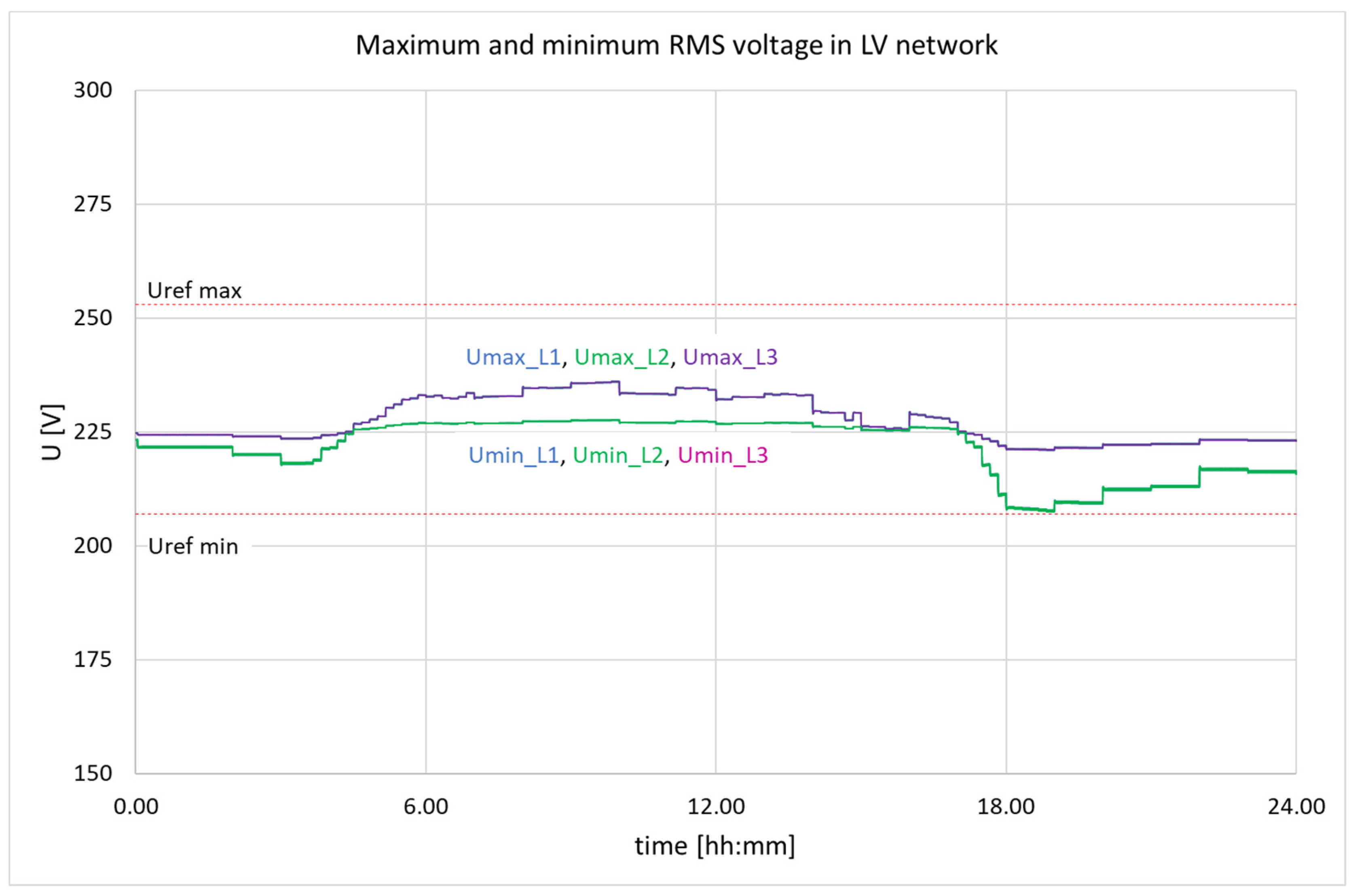
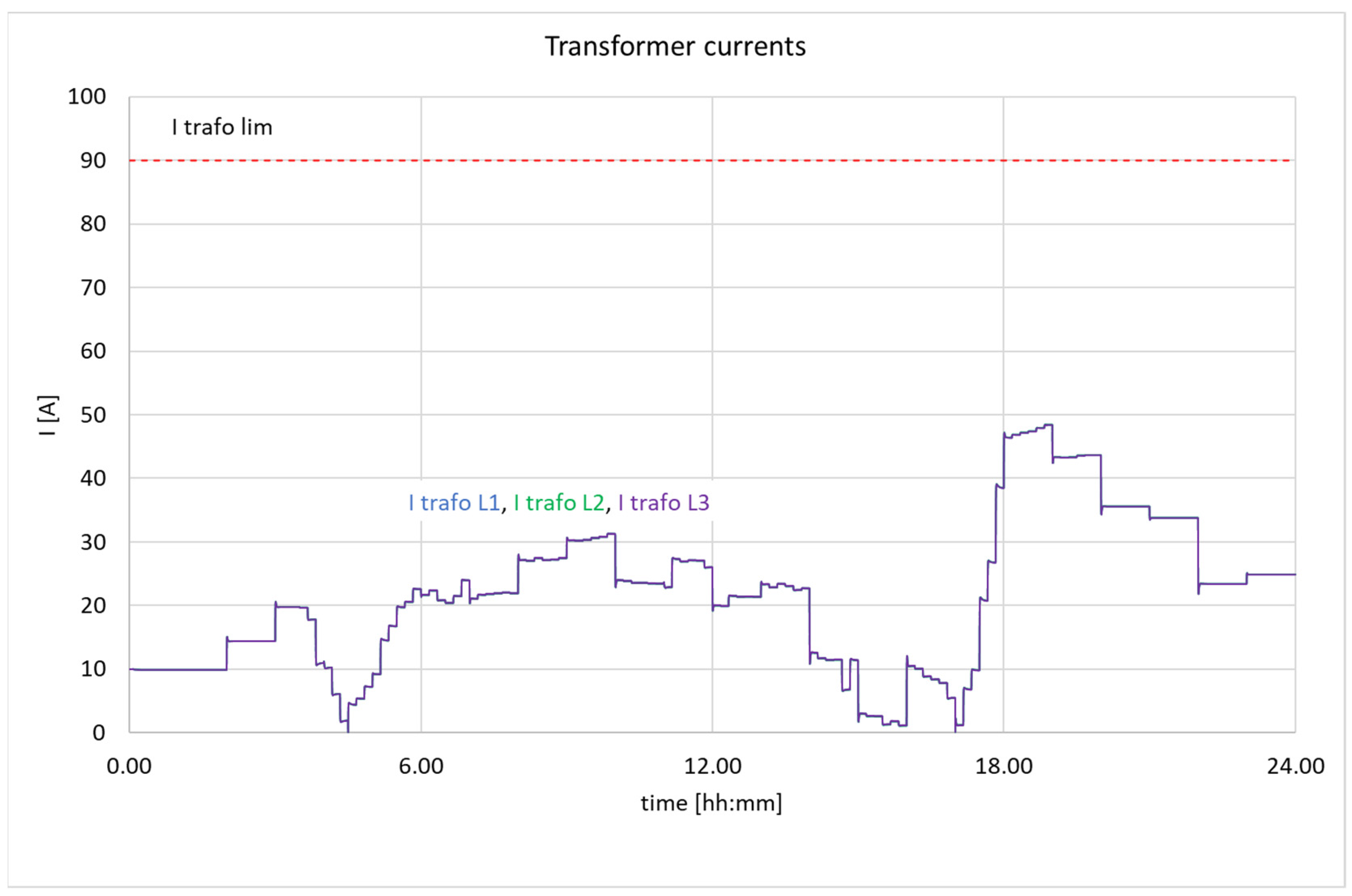

4. Summary of the Proposed Method
5. Conclusions
- Development of the control algorithm for the 3-phase 4-wire PV inverter, which allows the inverter to simultaneously perform the function of an interface for PV panels and a compensator for load unbalance and reactive power in the prosumer installation;
- Verification of the correctness of the developed algorithm using the simulation model of the real LV distribution network;
- Examination of effectiveness of the proposed control in terms of the variability of phase voltages in the grid nodes.
Author Contributions
Funding
Data Availability Statement
Conflicts of Interest
References
- Gabdullin, Y.; Azzopardi, B. Impacts of Photovoltaics in Low-Voltage Distribution Networks: A Case Study in Malta. Energies 2022, 15, 6731. [Google Scholar] [CrossRef]
- Gandhi, O.; Kumar, D.S.; Rodríguez-Gallegos, C.D.; Srinivasan, D. Review of Power System Impacts at High PV Penetration Part I: Factors Limiting PV Penetration. Sol. Energy 2020, 210, 181–201. [Google Scholar] [CrossRef]
- Sampath Kumar, D.; Gandhi, O.; Rodríguez-Gallegos, C.D.; Srinivasan, D. Review of Power System Impacts at High PV Penetration Part II: Potential Solutions and the Way Forward. Sol. Energy 2020, 210, 202–221. [Google Scholar] [CrossRef]
- Uzum, B.; Onen, A.; Hasanien, H.M.; Muyeen, S.M. Rooftop Solar PV Penetration Impacts on Distribution Network and Further Growth Factors—A Comprehensive Review. Electronics 2020, 10, 55. [Google Scholar] [CrossRef]
- Mukwekwe, L.; Venugopal, C.; Davidson, I.E. A Review of the Impacts and Mitigation Strategies of High PV Penetration in Low Voltage Networks. In Proceedings of the 2017 IEEE PES PowerAfrica, Accra, Ghana, 27–30 June 2017; IEEE: Piscataway, NJ, USA, 2017; pp. 274–279. [Google Scholar]
- Eltawil, M.A.; Zhao, Z. Grid-Connected Photovoltaic Power Systems: Technical and Potential Problems—A Review. Renew. Sustain. Energy Rev. 2010, 14, 112–129. [Google Scholar] [CrossRef]
- Lucas, A. Single-Phase PV Power Injection Limit Due to Voltage Unbalances Applied to an Urban Reference Network Using Real-Time Simulation. Appl. Sci. 2018, 8, 1333. [Google Scholar] [CrossRef]
- Brinkel, N.B.G.; Gerritsma, M.K.; AlSkaif, T.A.; Lampropoulos, I.; van Voorden, A.M.; Fidder, H.A.; van Sark, W.G.J.H.M. Impact of Rapid PV Fluctuations on Power Quality in the Low-Voltage Grid and Mitigation Strategies Using Electric Vehicles. Int. J. Electr. Power Energy Syst. 2020, 118, 105741. [Google Scholar] [CrossRef]
- De Silva, H.H.H.; Jayamaha, D.K.J.S.; Lidula, N.W.A. Power Quality Issues Due to High Penetration of Rooftop Solar PV in Low Voltage Distribution Networks: A Case Study. In Proceedings of the 2019 IEEE 14th International Conference on Industrial and Information Systems: Engineering for Innovations for Industry 4.0, ICIIS 2019—Proceedings 2019, Peradeniya, Sri Lanka, 18–20 December 2019; pp. 395–400. [Google Scholar] [CrossRef]
- Kharrazi, A.; Sreeram, V.; Mishra, Y. Assessment Techniques of the Impact of Grid-Tied Rooftop Photovoltaic Generation on the Power Quality of Low Voltage Distribution Network—A Review. Renew. Sustain. Energy Rev. 2020, 120, 109643. [Google Scholar] [CrossRef]
- Miller, W.; Liu, A.; Amin, Z.; Wagner, A. Power Quality and Rooftop-Photovoltaic Households: An Examination of Measured Data at Point of Customer Connection. Sustainability 2018, 10, 1224. [Google Scholar] [CrossRef]
- Ostrowska, A.; Michalec, Ł.; Skarupski, M.; Jasiński, M.; Sikorski, T.; Kostyła, P.; Lis, R.; Mudrak, G.; Rodziewicz, T. Power Quality Assessment in a Real Microgrid-Statistical Assessment of Different Long-Term Working Conditions. Energies 2022, 15, 8089. [Google Scholar] [CrossRef]
- Chamier-Gliszczynski, N.; Trzmiel, G.; Jajczyk, J.; Juszczak, A.; Woźniak, W.; Wasiak, M.; Wojtachnik, R.; Santarek, K. The Influence of Distributed Generation on the Operation of the Power System, Based on the Example of PV Micro-Installations. Energies 2023, 16, 1267. [Google Scholar] [CrossRef]
- Wang, X.; Wang, L.; Kang, W.; Li, T.; Zhou, H.; Hu, X.; Sun, K. Distributed Nodal Voltage Regulation Method for Low-Voltage Distribution Networks by Sharing PV System Reactive Power. Energies 2022, 16, 357. [Google Scholar] [CrossRef]
- Almeida, D.; Pasupuleti, J.; Ekanayake, J. Comparison of Reactive Power Control Techniques for Solar PV Inverters to Mitigate Voltage Rise in Low-Voltage Grids. Electronics 2021, 10, 1569. [Google Scholar] [CrossRef]
- Ariyaratna, P.; Muttaqi, K.M.; Sutanto, D. A Novel Control Strategy to Mitigate Slow and Fast Fluctuations of the Voltage Profile at Common Coupling Point of Rooftop Solar PV Unit with an Integrated Hybrid Energy Storage System. J. Energy Storage 2018, 20, 409–417. [Google Scholar] [CrossRef]
- Rafał, K.; Biskupski, J.; Bykuć, S.; Chaja, P. Dynamic Voltage Regulation and Unbalance Compensation in a Low-Voltage Distribution Network Using Energy Storage System. Appl. Sci. 2022, 12, 11678. [Google Scholar] [CrossRef]
- Mieński, R.; Urbanek, P.; Wasiak, I. Using Energy Storage Inverters of Prosumer Installations for Voltage Control in Low-Voltage Distribution Networks. Energies 2021, 14, 1121. [Google Scholar] [CrossRef]
- Ghasemi, M.A.; Parniani, M. Prevention of Distribution Network Overvoltage by Adaptive Droop-Based Active and Reactive Power Control of PV Systems. Electr. Power Syst. Res. 2016, 133, 313–327. [Google Scholar] [CrossRef]
- Gerdroodbari, Y.Z.; Razzaghi, R.; Shahnia, F. Decentralized Control Strategy to Improve Fairness in Active Power Cur-tailment of PV Inverters in Low-Voltage Distribution Networks. IEEE Trans. Sustain. Energy 2021, 12, 2282–2292. [Google Scholar] [CrossRef]
- Carpinelli, G.; Mottola, F.; Proto, D.; Varilone, P. Minimizing Unbalances in Low-Voltage Microgrids: Optimal Scheduling of Distributed Resources. Appl. Energy 2017, 191, 170–182. [Google Scholar] [CrossRef]
- Wasiak, I.; Szypowski, M.; Kelm, P.; Mieński, R.; Wędzik, A.; Pawełek, R.; Małaczek, M.; Urbanek, P. Innovative Energy Management System for Low-Voltage Networks with Distributed Generation Based on Prosumers’ Active Participation. Appl. Energy 2022, 312, 118705. [Google Scholar] [CrossRef]
- Buła, D.; Jarek, G.; Michalak, J.; Zygmanowski, M. Control Method of Four Wire Active Power Filter Based on Three-Phase Neutral Point Clamped T-Type Converter. Energies 2021, 14, 8427. [Google Scholar] [CrossRef]
- Ucar, M.; Ozdemir, E.; Kale, M. An Analysis of Three-Phase Four-Wire Active Power Filter for Harmonic Elimination Reactive Power Compensation and Load Balancing under Non-Ideal Mains Voltage. In Proceedings of the PESC Record—IEEE Annual Power Electronics Specialists Conference, Aachen, Germany, 20–25 June 2004; Volume 4, pp. 3089–3094. [Google Scholar] [CrossRef]
- Maciel, L.F.A.; Morales, J.L.M.; Gaona, D.C.; Pimentel, J.G.M. A Study of a Three-Phase Four-Wire Shunt Active Power Filter for Harmonics Mitigation. In Proceedings of the 2018 IEEE International Autumn Meeting on Power, Electronics and Computing ROPEC, Ixtapa, Mexico, 14–16 November 2018. [Google Scholar] [CrossRef]
- Vivek, P.; Muthuselvan, N.B. Investigation on Photovoltaic System Based Asymmetrical Multilevel Inverter for Harmonic Mitigation. In Proceedings of the 7th International Conference on Electrical Energy Systems, ICEES, Chennai, India, 11–13 February 2021; pp. 334–339. [Google Scholar] [CrossRef]
- Khaledian, A.; Vahidi, B.; Abedi, M. Harmonic Distorted Load Control in a Microgrid. J. Appl. Res. Technol. 2014, 12, 792–802. [Google Scholar] [CrossRef]
- Salmerón, P.; Herrera, R.S.; Vázquez, J.R. A New Approach for Three-Phase Loads Compensation Based on the Instanta-neous Reactive Power Theory. Electr. Power Syst. Res. 2008, 78, 605–617. [Google Scholar] [CrossRef]
- Pires, V.F.; Cordeiro, A.; Foito, D.; Pires, A.J.; Hao, C.; Martins, J.F.; Castro, R. Compensation of Unbalanced Low-Voltage Grids Using a Photovoltaic Generation System with a Dual Four-Leg, Two-Level Inverter. Electronics 2022, 11, 320. [Google Scholar] [CrossRef]
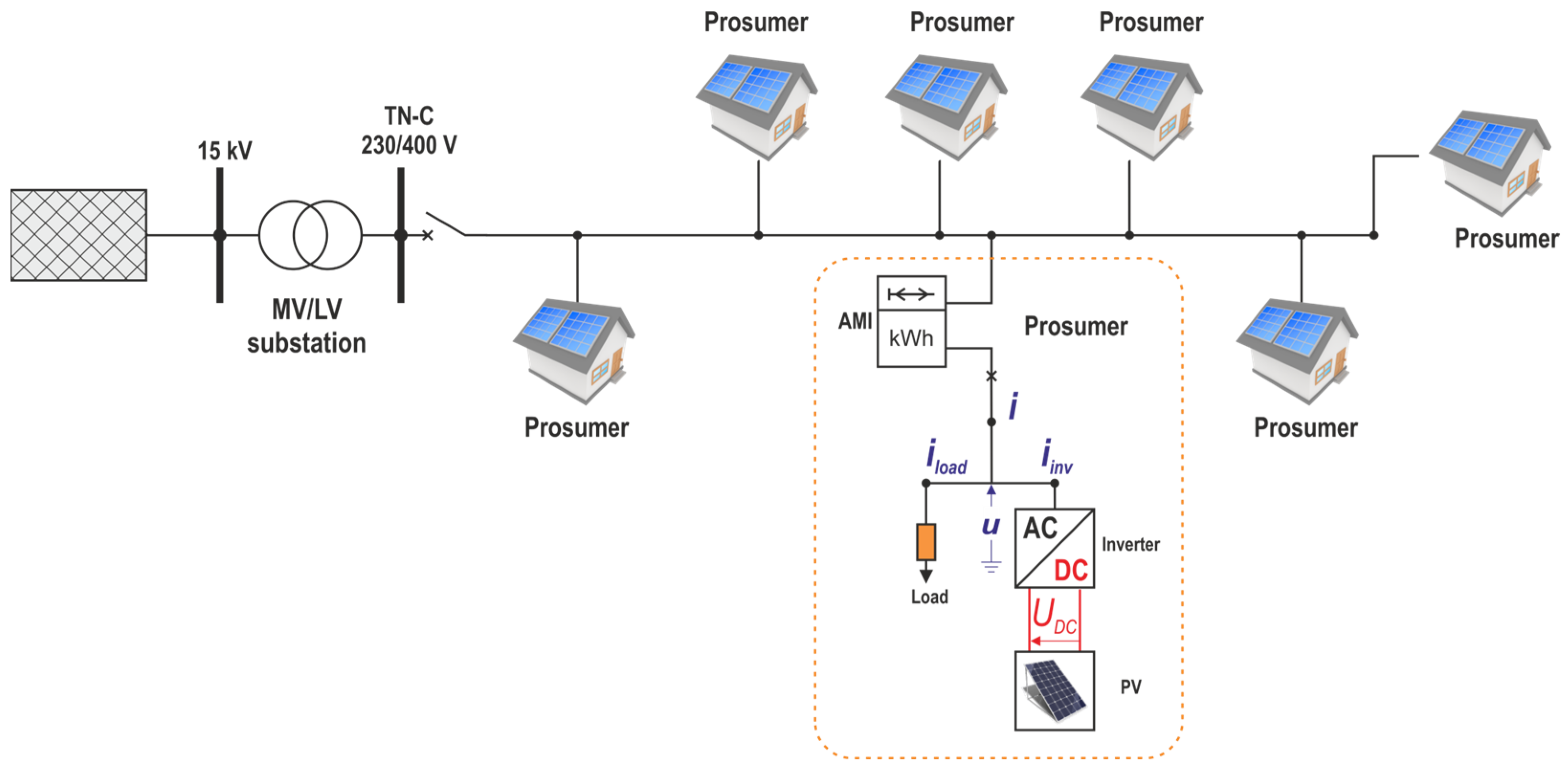
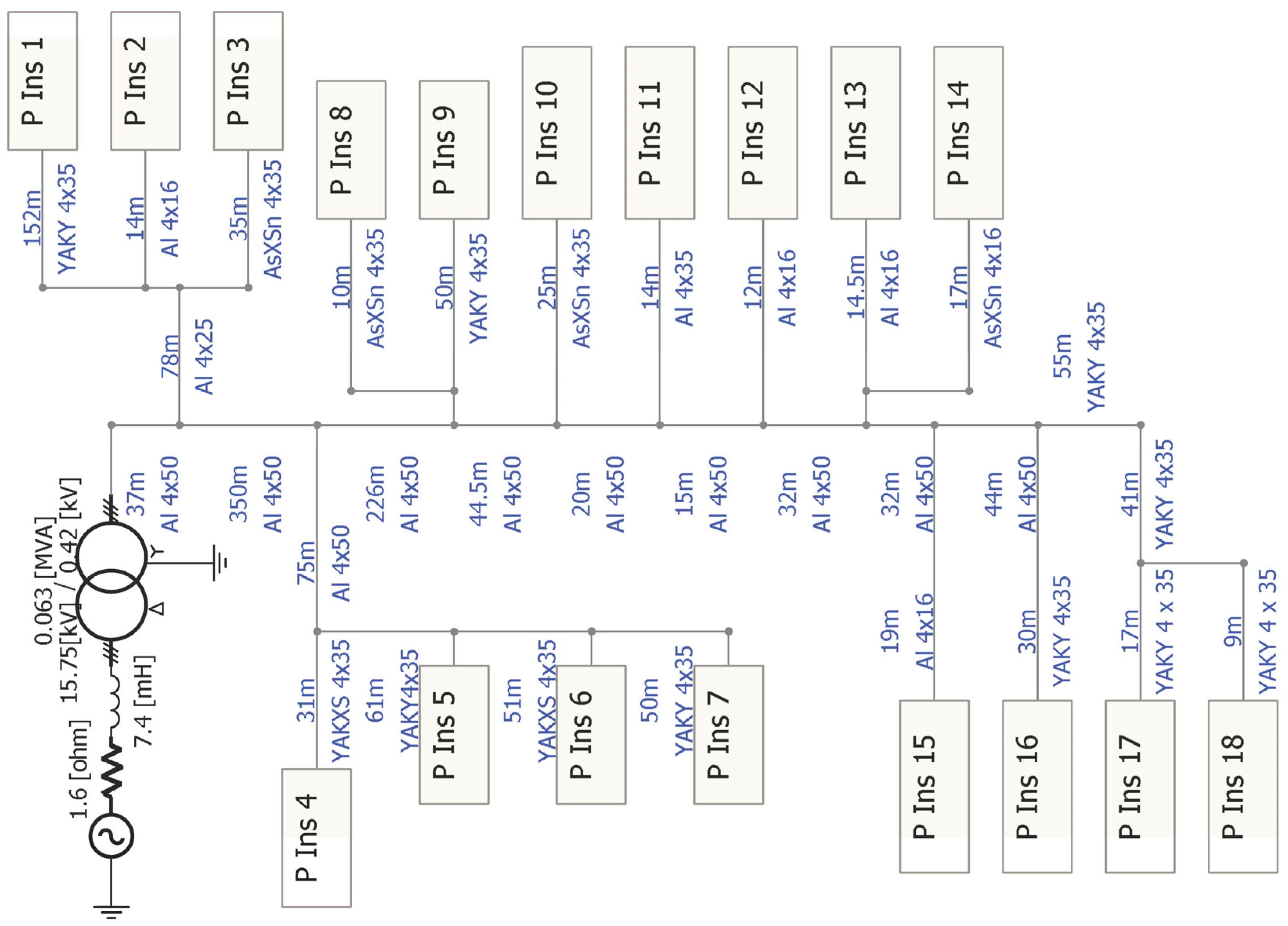
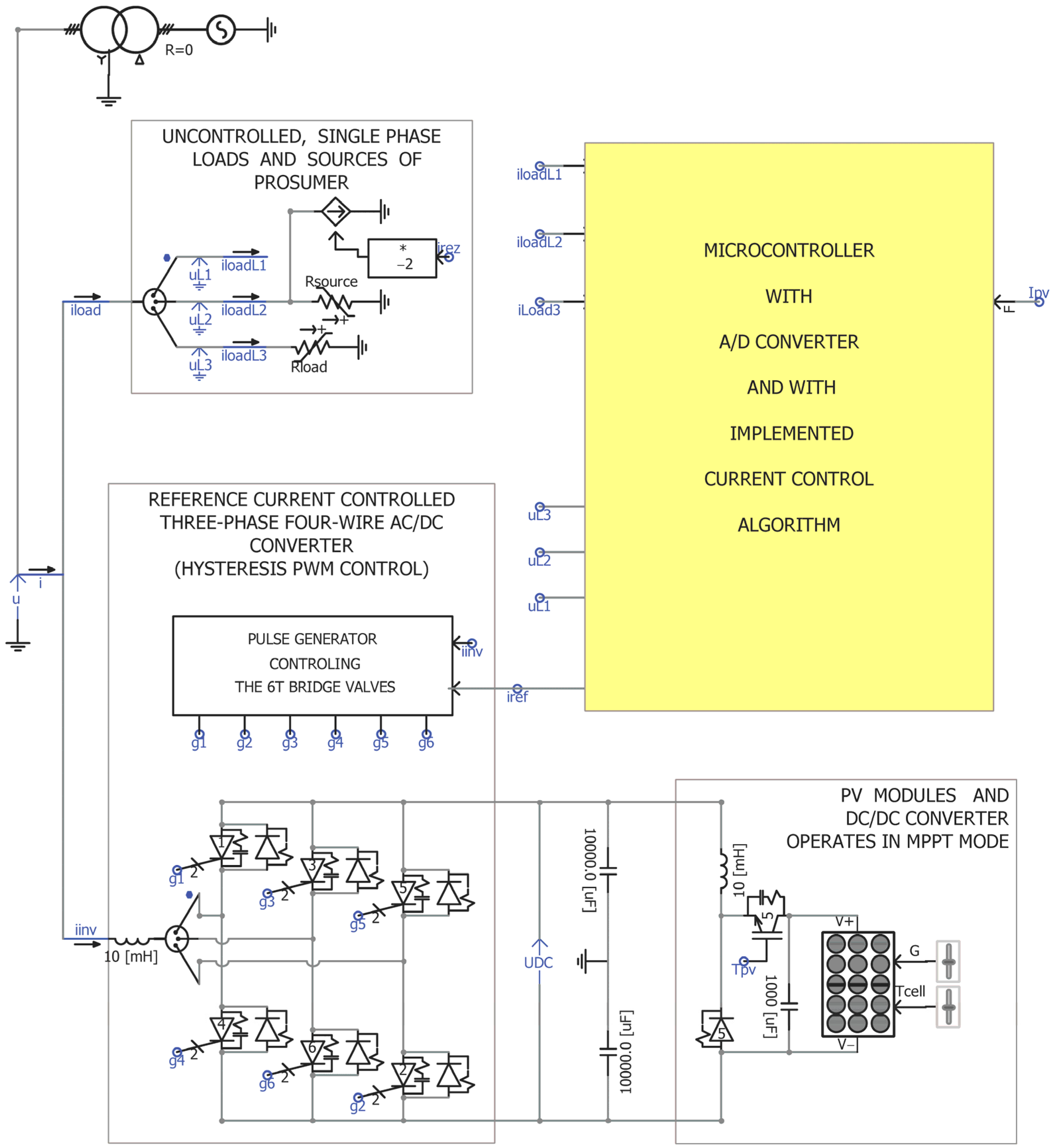


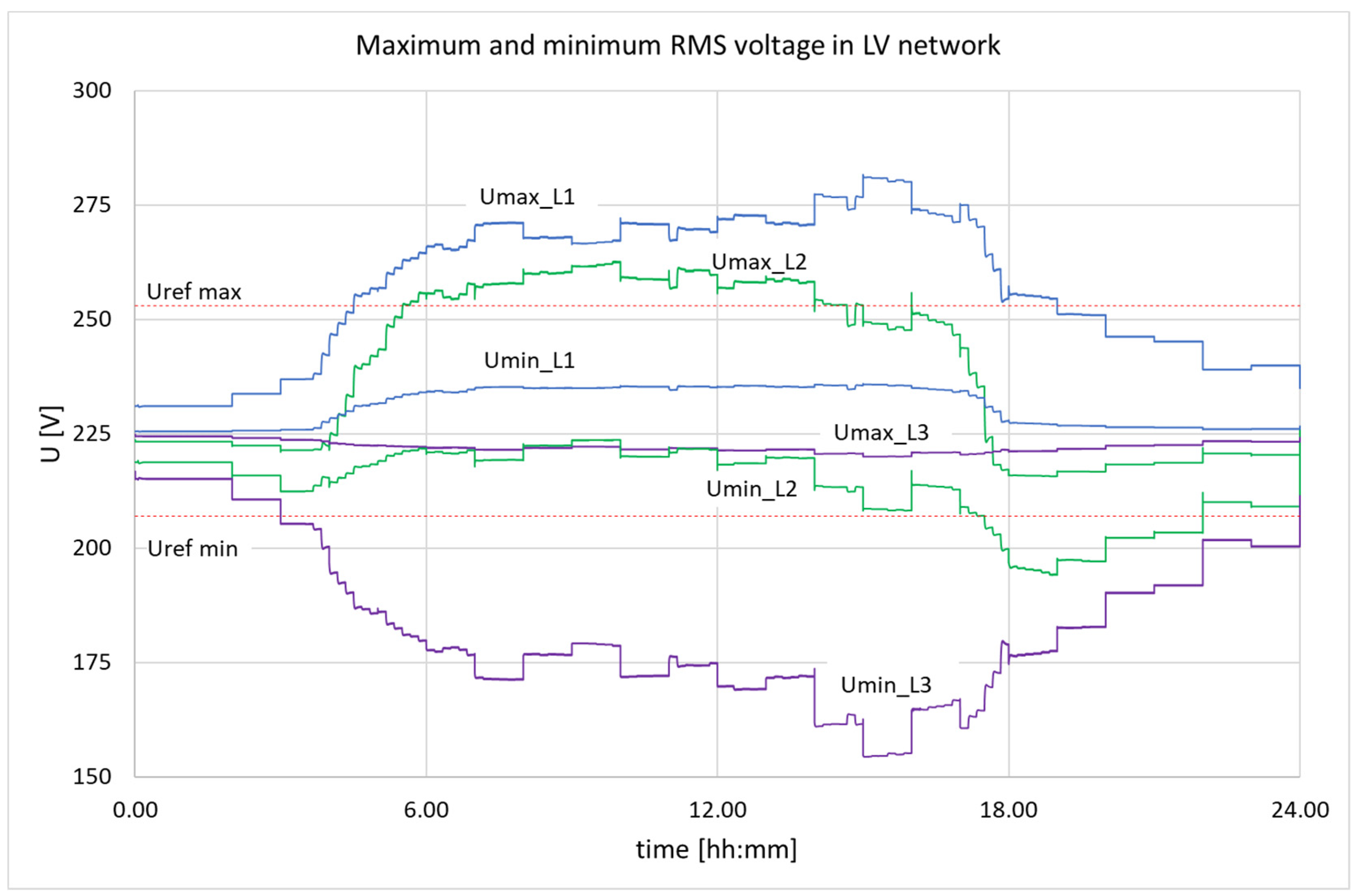
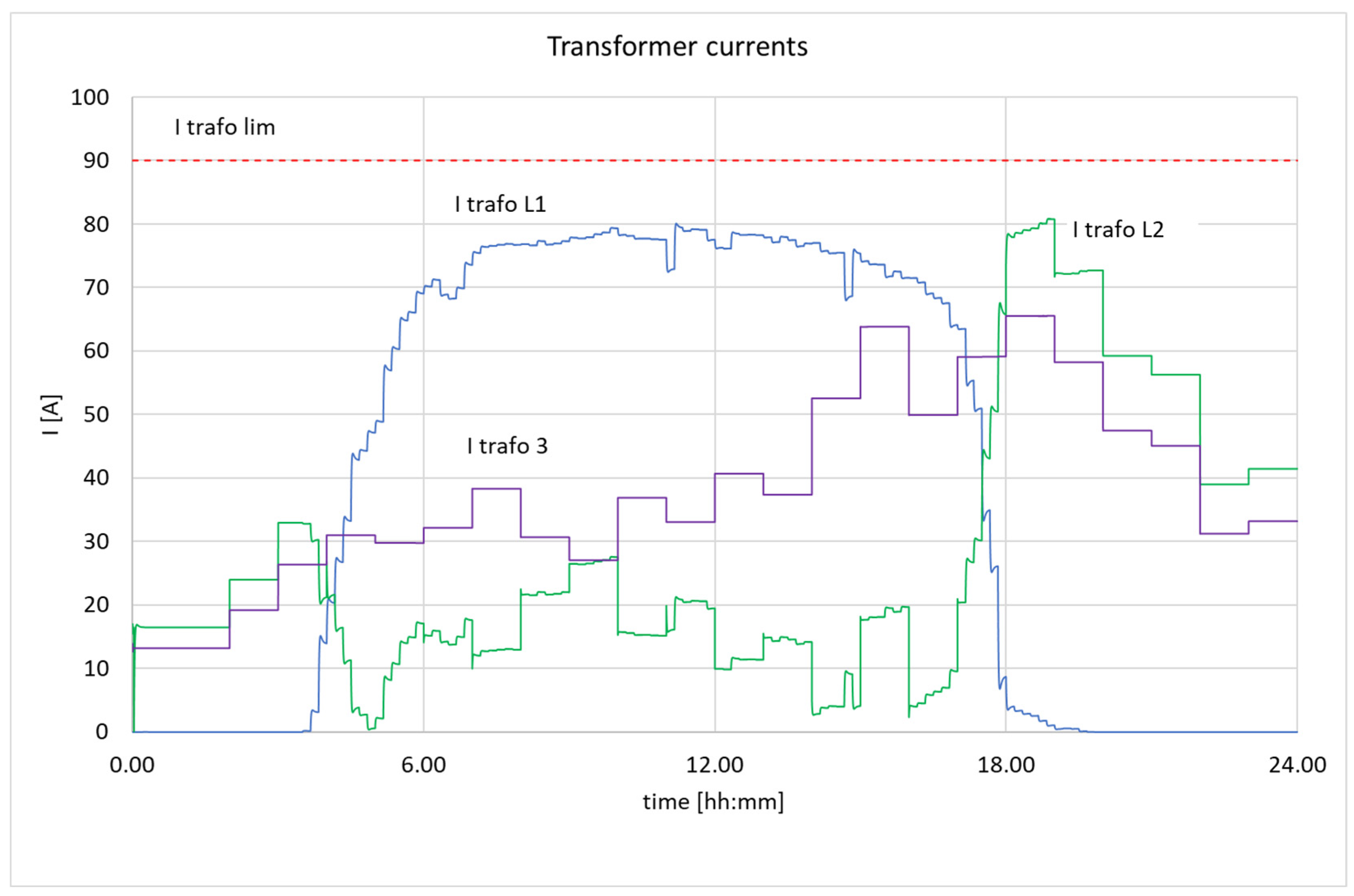
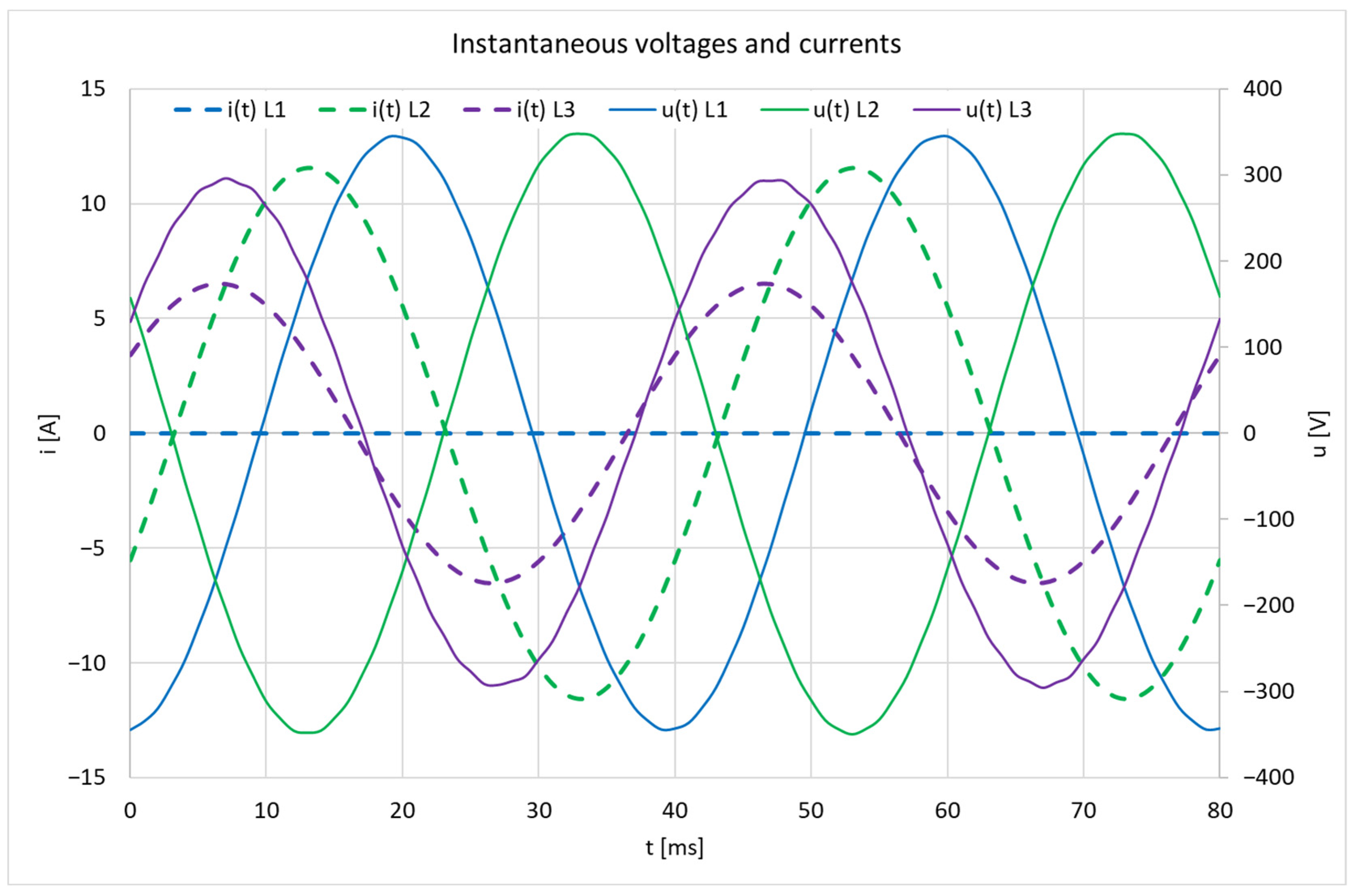
| Case Number | Prosumer Installation | Distribution Network | |||||
|---|---|---|---|---|---|---|---|
| PV Inverter | Balancing Algorithm Implemented | Inverter Valves Load Coefficient | Transformer | Voltages at PCCs | |||
| Pn | Type | Irms | Umax | Umin | |||
| - | [kW] | - | - | - | [A] | [V] | [V] |
| 1 | 2 | 1-phase | No | 1 | 87 | 282 | 155 |
| 2 | 2 | 3-phase | No | 0.36 | 82 | 272 | 178 |
| 3 | 2 | 3-phase | Yes | 0.98 | 50 | 237 | 208 |
| 4 | 4 | 3-phase | Yes | 1.3 | 80 | 252 | 208 |
| Feature | PV Inverters [14,15,20,22] | ESSs [16,17,18,22] | Static Compensators [23,24,25] | PV Inverters with the Proposed Control |
|---|---|---|---|---|
| Application effects |
|
|
|
|
| Algorithm complexity |
|
|
|
|
| Impact on the grid |
|
|
|
|
| Implementation costs |
|
|
|
|
| Strengths |
|
|
|
|
| Weaknesses |
|
|
|
|
Disclaimer/Publisher’s Note: The statements, opinions and data contained in all publications are solely those of the individual author(s) and contributor(s) and not of MDPI and/or the editor(s). MDPI and/or the editor(s) disclaim responsibility for any injury to people or property resulting from any ideas, methods, instructions or products referred to in the content. |
© 2023 by the authors. Licensee MDPI, Basel, Switzerland. This article is an open access article distributed under the terms and conditions of the Creative Commons Attribution (CC BY) license (https://creativecommons.org/licenses/by/4.0/).
Share and Cite
Mieński, R.; Wasiak, I.; Kelm, P. Integration of PV Sources in Prosumer Installations Eliminating Their Negative Impact on the Supplying Grid and Optimizing the Microgrid Operation. Energies 2023, 16, 3479. https://doi.org/10.3390/en16083479
Mieński R, Wasiak I, Kelm P. Integration of PV Sources in Prosumer Installations Eliminating Their Negative Impact on the Supplying Grid and Optimizing the Microgrid Operation. Energies. 2023; 16(8):3479. https://doi.org/10.3390/en16083479
Chicago/Turabian StyleMieński, Rozmysław, Irena Wasiak, and Paweł Kelm. 2023. "Integration of PV Sources in Prosumer Installations Eliminating Their Negative Impact on the Supplying Grid and Optimizing the Microgrid Operation" Energies 16, no. 8: 3479. https://doi.org/10.3390/en16083479
APA StyleMieński, R., Wasiak, I., & Kelm, P. (2023). Integration of PV Sources in Prosumer Installations Eliminating Their Negative Impact on the Supplying Grid and Optimizing the Microgrid Operation. Energies, 16(8), 3479. https://doi.org/10.3390/en16083479






